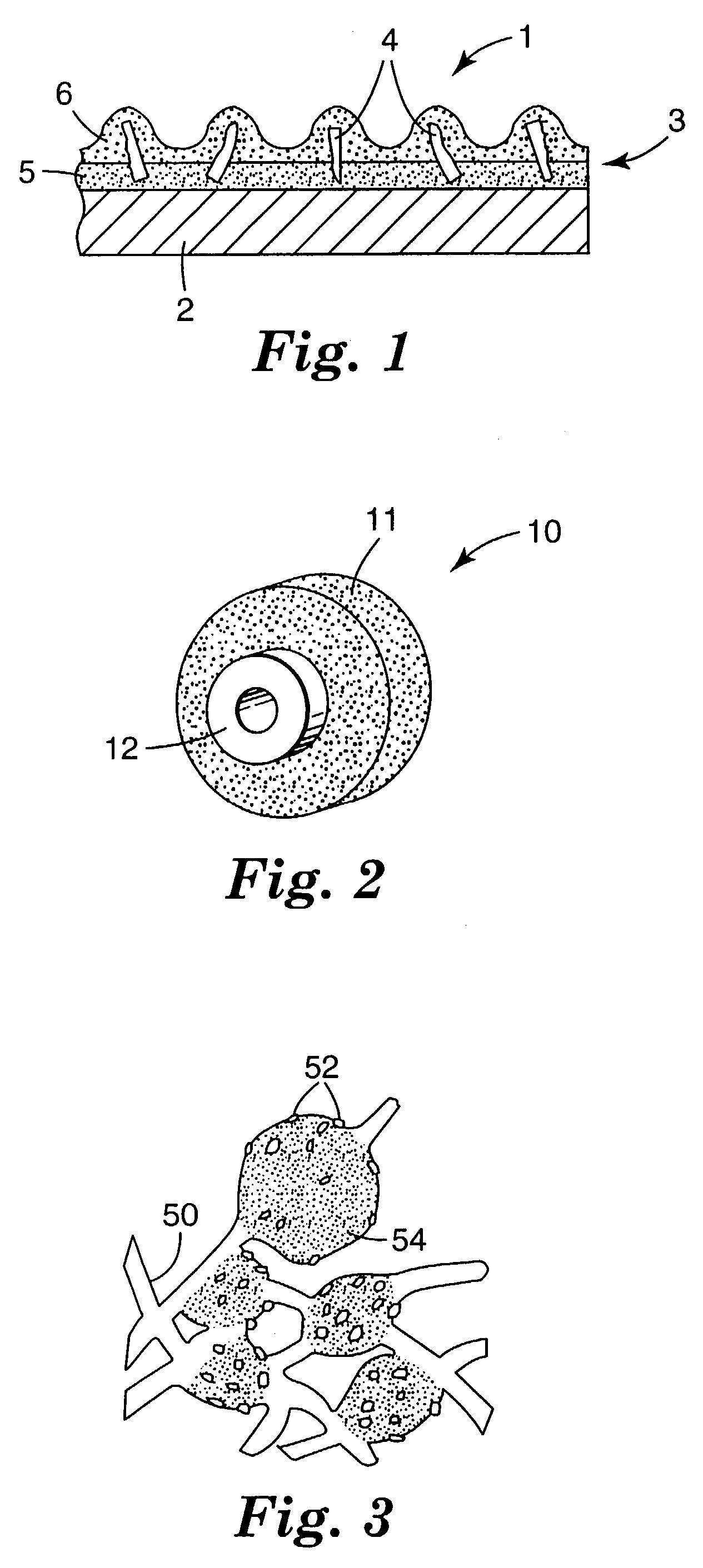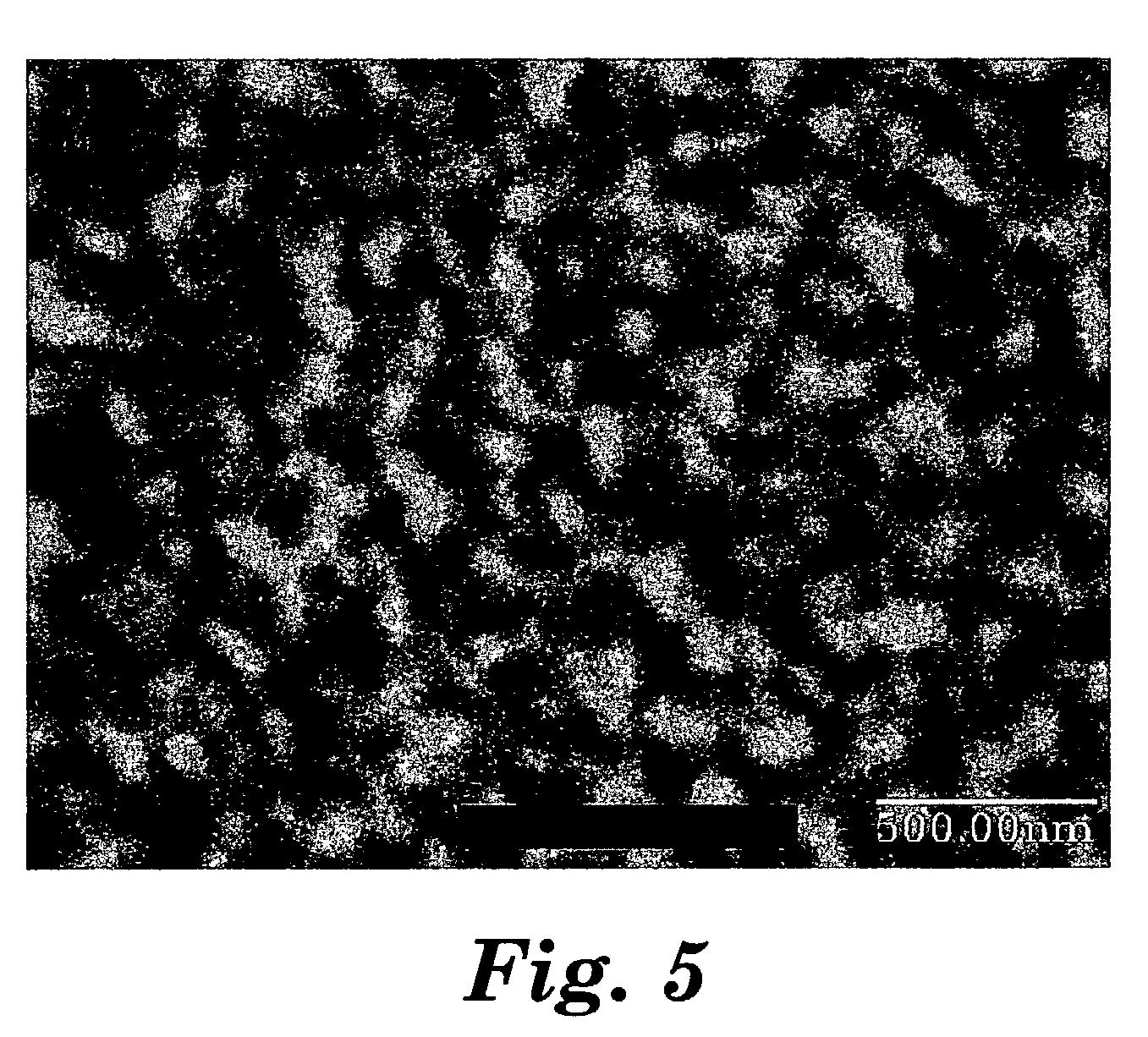[0080]In some embodiments, it may be advantageous for at least a portion of a
metal oxide source (in some embodiments, 10, 15, 20, 25, 30, 35, 40, 45, 50, 55, 60, 65, 70, 75, 80, 85, 90, 95, or even 100 percent by weight) to be obtained by adding particulate, metallic material comprising at least one of a
metal (e.g., Al, Ca, Cu, Cr, Fe, Li, Mg, Ni, Ag, Ti, Zr, and combinations thereof), M, that has a negative
enthalpy of
oxide formation or an
alloy thereof to the melt, or otherwise combining them with the other raw materials. Although not wanting to be bound by theory, it is believed that the heat resulting from the
exothermic reaction associated with the oxidation of the metal is beneficial in the formation of a homogeneous melt and resulting glass. For example, it is believed that the additional heat generated by the oxidation reaction within the
raw material eliminates or minimizes insufficient
heat transfer, and hence facilitates formation and homogeneity of the melt, particularly when forming glass particles with x, y, and z dimensions over 50 (over 100, or even over 150) micrometers. It is also believed that the availability of the additional heat aids in driving various chemical reactions and physical processes (e.g., densification, and spherodization) to completion. Further, it is believed for some embodiments, the presence of the additional heat generated by the oxidation reaction actually enables the formation of a melt, which otherwise is difficult or otherwise not practical due to high
melting point of the materials. Further, the presence of the additional heat generated by the oxidation reaction actually enables the formation of glass that otherwise could not be made, or could not be made in the desired size range. Another
advantage of the invention include, in forming the glasses, that many of the chemical and physical processes such as melting, densification and spherodizing can be achieved in a short time, so that very high quench rates may be achieved. For additional details, see co-pending application having U.S. Ser. No. 10 / 211,639, filed the Aug. 2, 2002, the disclosure of which is incorporated herein by reference.
[0081]In one aspect of the invention, the raw materials are fed independently to form the molten mixture. In another aspect of the invention, certain raw materials are mixed together, while other raw materials are added independently into the molten mixture. In some embodiments, for example, the raw materials are combined or mixed together prior to melting. The raw materials may be combined in any suitable and known manner to form a substantially homogeneous mixture. These combining techniques include ball milling, mixing, tumbling and the like. The milling media in the
ball mill may be metal balls, ceramic balls and the like. The ceramic milling media may be, for example,
alumina, zirconia, silica, magnesia and the like. The ball milling may occur dry, in an aqueous environment, or in a
solvent-based (e.g.,
isopropyl alcohol) environment. If the
raw material batch contains metal powders, then it is generally desired to use a
solvent during milling. This
solvent may be any suitable material with the appropriate
flash point and ability to disperse the raw materials. The milling time may be from a few minutes to a few days, generally between a few hours to 24 hours. In a wet or
solvent based milling
system, the
liquid medium is removed, typically by
drying, so that the resulting mixture is typically homogeneous and substantially devoid of the water and / or solvent. If a
solvent based milling
system is used, during
drying, a solvent
recovery system may be employed to recycle the solvent. After
drying, the resulting mixture may be in the form of a “dried cake”. This cake like mixture may then be broken up or crushed into the desired particle size prior to melting. Alternatively, for example, spray-drying techniques may be used. The latter typically provides spherical
particulates of a desired oxide mixture. The precursor material may also be prepared by wet chemical methods including
precipitation and
sol-gel. Such methods will be beneficial if extremely high levels of homogeneity are desired.
[0082]Particulate raw materials are typically selected to have particle sizes such that the formation of a homogeneous melt can be achieved rapidly. Typically, raw materials with relatively small average particle sizes and narrow distributions are used for this purpose. In some methods (e.g.,
flame forming and
plasma spraying), particularly desirable particulate raw materials are those having an average particle size in a range from about 5 nm to about 50 micrometers (in some embodiments, in a range from about 10 nm to about 20 micrometers, or even about 15 nm to about 1
micrometer), wherein at least 90 (in some embodiments, 95, or even 100) percent by weight of the particulate, although sizes outside of the sizes and ranges may also be useful. Particulate less than about 5 nm in size tends to be difficult to
handle (e.g., the flow properties of the feed particles tended to be undesirable as they tend to have poor flow properties). Use of particulate larger than about 50 micrometers in typical
flame forming or
plasma spraying processes tend to make it more difficult to obtain homogenous melts and amorphous materials and / or the desired composition.
[0083]Furthermore, in some cases, for example, when
particulate material is fed in to a
flame or thermal or
plasma spray apparatus, to form the melt, it may be desirable for the particulate raw materials to be provided in a range of particle sizes. Although not wanting to be bound by theory, it is believed that this maximizes the packing density and strength of the feed particles. In general the coarsest
raw material particles are smaller than the desired melt or
glass particle sizes. Further, raw material particles that are too coarse, tend to have insufficient thermal and mechanical stresses in the feed particles, for example, during a flame forming or plasma spraying step. The end result in such cases is generally, fracturing of the feed particles in to smaller fragments, loss of compositional uniformity, loss of yield in desired
glass particle sizes, or even incomplete melting as the fragments generally change their trajectories in a multitude of directions out of the heat source.
[0084]The glasses and ceramics comprising glass can be made, for example, by heating (including in a flame or plasma) the appropriate metal oxide sources to form a melt, desirably a homogenous melt, and then rapidly cooling the melt to provide glass. Some embodiments of glasses can be made, for example, by melting the metal oxide sources in any suitable furnace (e.g., an inductively or resistively heated furnace, a gas-fired furnace, or an electrical furnace).
[0085]The glass is typically obtained by relatively rapidly cooling the
molten material (i.e., the melt). The quench rate (i.e., the
cooling time) to obtain the glass depends upon many factors, including the
chemical composition of the melt, the glass-forming ability of the components, the thermal properties of the melt and the resulting glass, the
processing technique(s), the dimensions and
mass of the resulting glass, and the cooling technique. In general, relatively higher quench rates are required to form glasses comprising higher amounts of Al2O3 (i.e., greater than 75 percent by weight Al2O3), especially in the absence of known glass formers such as SiO2, B2O3, P2O5, GeO2, TeO2, As2O3, and V2O5. Similarly, it is more difficult to cool melts into glasses in larger dimensions, as it is more difficult to remove heat fast enough.
 Login to View More
Login to View More 


